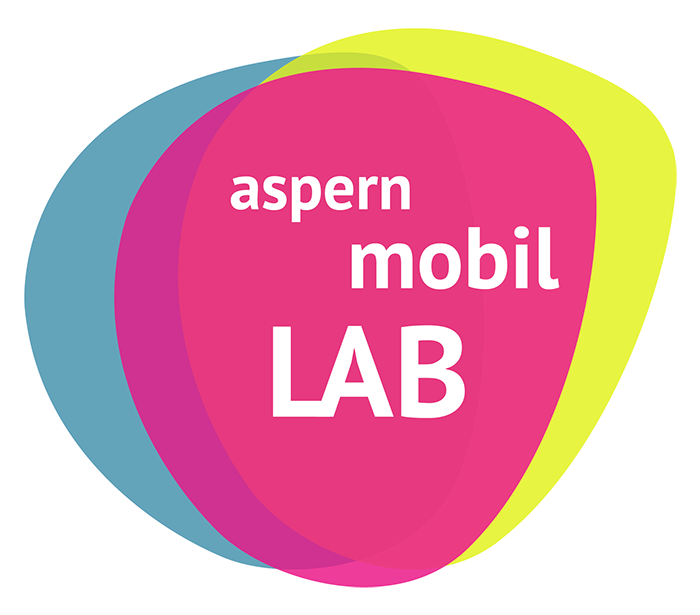Uni in der Seestadt – Game night
Recap – joint games afternoon
On Wednesday, 10.01.2024 our students tested so-called “design games” with you between 16:00 and 19:00.
The visitors played specially designed games with us and our students, each of which had a specific student project as its theme. By playing together, we were able to exchange different perspectivesand at the same time our students gained valuable insights into the further development of the projects and ideas.
Thank you very much for coming and see you next time!
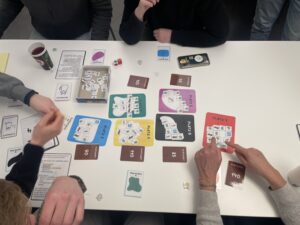
© aspern.mobil LAB
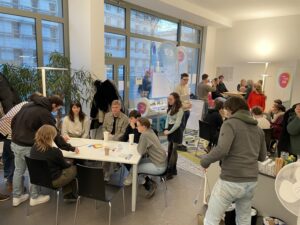
© aspern.mobil LAB
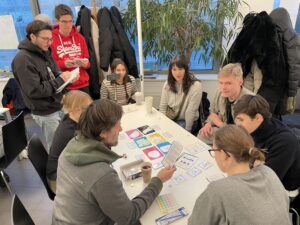
© aspern.mobil LAB
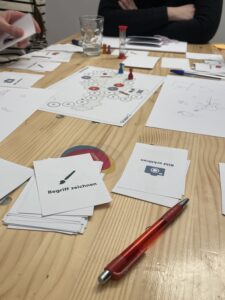
Design games are a wonderful tool for discussing important issues that arise during the development of an idea or product with users and other stakeholders. We do this in a relaxed, playful atmosphere and thus clarify the design and research questions of our students. The students’ projects deal with current issues relating to mobility, climate change, sustainability and the use of public spaces.
For further information, please send an email to gerfried.mikusch@mobillab.wien!
Brief description of the projects
PlazaPoll
The little-used asphalt surfaces in Seestadt currently offer residents few benefits. In keeping with the sense of community that characterises Seestadt, our aim is to transform these asphalt surfaces through collaborative design, incorporating useful elements that increase community satisfaction. Our idea is a modular building system where participants can choose which features they want most for the new artefact, e.g. shading elements. These are discussed and evaluated by urban planners, who provide meaningful concrete ideas for the use of the empty space. Residents can then vote on their preferred ideas, which will be visualised, e.g. with 3D images, to support their visions. Voting will take place via user interfaces that will be placed on the empty public spaces to be redesigned. The focus of our idea is to involve all generations of Seestadt by giving them a voice and to use what already exists to create something new together in a sustainable way. In doing so, participatory design will include different perspectives, encourage ownership and community engagement and result in a more functional and user-friendly space. After a reassessment by the community, the project will be realised and the input facility will move to the next available space.
Language Integration Game
The Language Integration Game (LIG) is designed to make it possible to practise learning new languages actively and creatively. The learning methods are therefore to be provided with playful elements and a tangible interface. Our aim is to strengthen social sustainability by creating communities and supporting integration. In addition, learning spaces, such as the language café, create opportunities for communication infrastructure. Our target group is people in Seestadt who want to learn new languages and become more integrated into the community. More specifically, our target group should include people who visit the language café in Seestadt. As a result, the language café is also the main stakeholder of our project.
HarmoniBench
aspern Seestadt offers an excellent setting for community interaction. There is a need for innovative and creative public spaces and our project aims to develop a unique concept to achieve this goal. While urban designs often consider physical infrastructure, few consider the harmonious integration of creativity in the public realm. The potential of public spaces as hubs for both entertainment and education remain largely untapped. The introduction of interactive music benches in the Seestadt public space fosters community engagement, cultural learning and modernises the area.
Kunstfluss In Seestadt (KISS)
The aim of our project is to sustainably support the local art scene by providing a platform for local and up-and-coming artists. To achieve this, we want to integrate the works of local artists into the infrastructure of Seestadt. This should make art an essential part of the cultural identity of Seestadt and strengthen the sense of community among all residents. As part of the project, infrastructure will therefore be created to present works of art to the public. People can interact with the works and rate them. Residents can collect points by participating and then redeem them for discounts when purchasing merchandise products from the exhibited artworks, which are available at the tourist office.
Aspern Adventure Hubs
The “Aspern Adventure Hubs” project aims to facilitate interactions at stations strategically placed at real locations in aspern Seestadt to encourage spontaneous, personal interactions in the real world through playful challenges and rewards. The application encourages users to not only navigate their real-world surroundings, but also to discover new things, complete tasks and earn rewards at each station. It fosters a sense of community by facilitating connections between users and effectively translating online interactions into meaningful offline encounters. By integrating elements of gamified health benefits, climate change initiatives and friendly competitions, it responds to the interests and concerns of an active and environmentally conscious demographic. By bringing individuals together, the application encourages the growth of local communities. It can be closely linked to the infrastructure of Seestadt, local businesses and social events.
EcoMate
The proposed idea is to develop a smart home system that introduces an innovative and effective gamification model to promote sustainability practices. The initial focus is on private homes, as the existing infrastructure of smart home systems provides a solid working basis. However, if successful, the idea could be extended to offices and communal living spaces at a later stage. The key features of the system would be that it is able to provide real-time information on energy consumption, operating modes and appliance status and allow users to control them. The implementation of smart grids is also an important element, as they enable optimised control and monitoring of energy consumption. We are considering microgrids as they offer greater resilience and flexibility, especially in times of disruption or peak demand. The exact gamification model we use can be further improved based on future insights. However, we are aiming for a unique approach that increases user engagement and explores both reward and punishment as psychological strategies. The product should rather be integrated into the environment and be completely virtual. It should have an appealing and innocent appearance. A representation in the shape of a dolphin, polar bear or penguin is being considered.
Citizen science for infrastructure decisions
Utilise citizen science and reliable public information to improve future infrastructure decisions. Establish dynamic feedback mechanisms and easily accessible project details to empower both informed decision-makers and engaged citizens. Create a standard method for projects to communicate with citizens and provide a tool for them to have a low-threshold impact.
